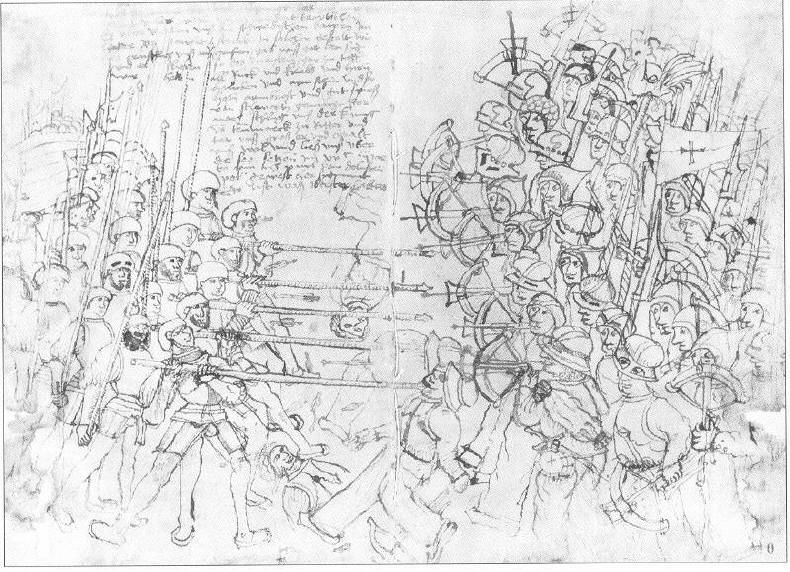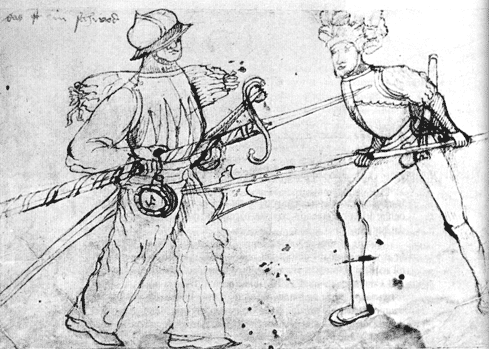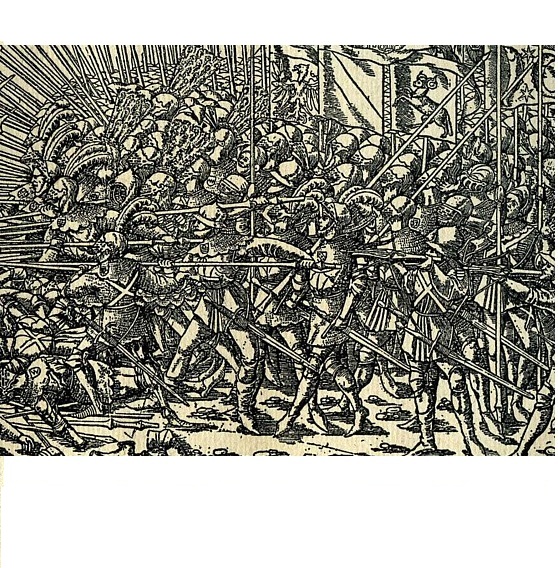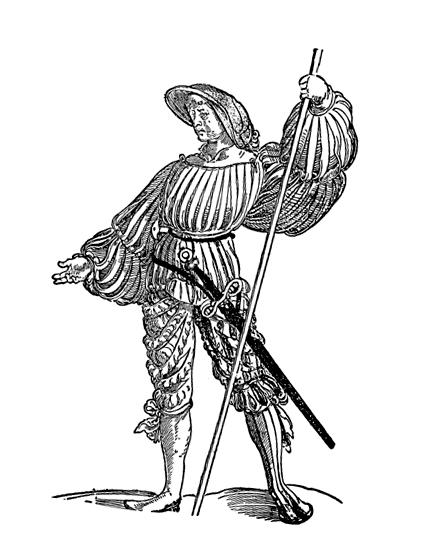Friends,
I'm wondering what sort of historical costume/kit might be appropriate for this sword? http://www.deltin.net/5161-2.htm
Though I have many visual sources on late Medieval/early Renaissance costume, none address Sweden specifically. At the moment I'm more interested in "soft kit" because, with one more chance to visit the local Renaissance Faire this year, I may be able to find something fitting and accurate.
Thanks in advance,
r
PS: Del Tin, Albion, and other makers invariably describe this sword style as Swedish, but at least one similar sword (in the Stone Gallery, Metropolitan Museum of Art) is described as German. See:
http://www.forensicfashion.com/1529AustrianKnightSword.html
My guess would be a late 15th Century/early 16th Century kit. After about the 1520's you start seeing more complex compound hilted Longswords as they evolve to Side Swords and eventually later 17th century swords like Mortuarys, Walloons and Basket hilts in Northern Europe. During the same period you start seeing Italian Rapiers and such come into use, but in the early 16th century those are mostly found in Southern Europe more than Northern Europe. Though an odd traveller might be carrying an early Rapier type. I carry a Longsword like this for my Renaissance Faires, but in truth the simple cross Longsword is probably obsolete by the later 16th century, though you might see it still if carried by poorer civilian travelers. Rapiers and Side Swords would be better in the later part of the 16th century, where most Ren Faires take place. However since I don't like Rapiers and like Longswords a lot more, I carry my Longsword at all Ren Faires I attend. The funny thing is that no one says anything about the sword I carry since most other Faire people or patrons don't know the difference anyway and usually carry any old sword like object they can afford!
The above is my own conjecture, observations and guide. I'm sure other people on this forum other opinions and might be more specific or correct than I. I'm welcome to being corrected here. :-)
The above is my own conjecture, observations and guide. I'm sure other people on this forum other opinions and might be more specific or correct than I. I'm welcome to being corrected here. :-)
Hi Bryce,
Yes, I've also read similar things regarding Europe generally, but did these also apply to Sweden? Costume surveys of this time period which I've consulted focus on England, France, Italy, Germany, and Spain, giving little attention to Scandinavia. While it's tempting to extend observations from those places to Sweden, I'd rather not do so; working from actual Swedish sources is the safest way to proceed.
On a related note, I do have a fascinating essay in Spanish -- "Los suecos seguidores de la moda en traje español" (in El Quixote en sus trajes 2005) -- describing the Swedish adoption of Hapsburg Spanish fashion during the Vasa dynasty. However, this period is slightly too late to be useful to a costume reconstruction for my longsword.
Reference:
http://www.forensicfashion.com/ReferencesInPrintSpanishQ.html
Yes, I've also read similar things regarding Europe generally, but did these also apply to Sweden? Costume surveys of this time period which I've consulted focus on England, France, Italy, Germany, and Spain, giving little attention to Scandinavia. While it's tempting to extend observations from those places to Sweden, I'd rather not do so; working from actual Swedish sources is the safest way to proceed.
On a related note, I do have a fascinating essay in Spanish -- "Los suecos seguidores de la moda en traje español" (in El Quixote en sus trajes 2005) -- describing the Swedish adoption of Hapsburg Spanish fashion during the Vasa dynasty. However, this period is slightly too late to be useful to a costume reconstruction for my longsword.
Reference:
http://www.forensicfashion.com/ReferencesInPrintSpanishQ.html
Scandinavian fashion in both clothing and arms would probably follow the general development in Northern Europe but with a delay and simplified. Many of the simpler sword designs in museums in Norway and Sweden are dated surprisingly late. Scandinavia was scarcely populated and the nobility was relatively poor compared to continental Europe.
Such a sword would probably have been wielded by a professional man-at-arms, either a knight (swe: riddare) or squire (swe: sven). Here are a few period depictions of upper class Swedes (enacting biblical motifs):
[ Linked Image ]
[ Linked Image ]
[ Linked Image ]
[ Linked Image ]
[ Linked Image ]
[ Linked Image ]
[ Linked Image ]
[ Linked Image ]
[ Linked Image ]
[ Linked Image ]
[ Linked Image ]
[ Linked Image ]
It's called Swedish because the sword it was based off of was found in the grave of a Swede. :)
This sword was owned by Svante Nilsson Sture, a Swedish Viceroy. I'd imagine it would be most appropriate for a higher station kit, fitting its owner's status.
The German sword you linked to on your website is very different from the sword under discussion. While the guard has a similar curve, the pommels are different, as are the blades.
[ Linked Image ]
This sword was owned by Svante Nilsson Sture, a Swedish Viceroy. I'd imagine it would be most appropriate for a higher station kit, fitting its owner's status.
The German sword you linked to on your website is very different from the sword under discussion. While the guard has a similar curve, the pommels are different, as are the blades.
[ Linked Image ]
Thank you, friends! Mikael, those images and terms are very helpful. The costumes look enough like other late medieval clothing that I may be able to find something similar at the Renaissance Faire. Seeing them makes the subsequent transition to Spanish fashion, as documented in the article cited above, all the more dramatic.
Chad, I see what you mean regarding the Stone Gallery sword's differences from the Svante type. Still, to me it seems more similar to the Svante than to other German longswords of the time. Aside from the similar guard, its hilt-to-blade proportion is much longer, and it lacks complex hilt features like rings or spiralling. Of course, there's no reason that swords with these general features could not have been native to both northern Germany and southern Sweden, or made in one place and been exported or adopted by the other.
Chad, I see what you mean regarding the Stone Gallery sword's differences from the Svante type. Still, to me it seems more similar to the Svante than to other German longswords of the time. Aside from the similar guard, its hilt-to-blade proportion is much longer, and it lacks complex hilt features like rings or spiralling. Of course, there's no reason that swords with these general features could not have been native to both northern Germany and southern Sweden, or made in one place and been exported or adopted by the other.
Svante Sture's widow preserved his and his sons' clothing after their deaths, and these garments can now be found in the Cathedral Museum in Uppsala, Sweden. Here are some photos/pics from various sources which may be of some help.
Edited to remove images (wrong era: see below)
Edited to remove images (wrong era: see below)
Last edited by David McElrea on Fri 20 May, 2011 3:03 pm; edited 1 time in total
The clothing in the Cathedral museum belonged to Svante Stensson Sture who was killed in 1567, the sword in question belonged to Svante Nilsson Sture who died in 1512. Swedish noble families tended to use only a few male names which makes it hard to keep them apart without the patronymic.
Ah, Daniel. Thank you for that. Sorry to have introduced a false lead...
You can try looking into some of the images from the war diary of the Landsknecht Paul Dolnstein during 1500-1505 ish.
There are depictions of Swedish commoners and melitia that might be helpful to you if thats what you were aiming for as some of them used longswords by the looks of it. Otherwise im stumped as Im unsure of any other sources really :\
hope it helps!
 Attachment: 124.85 KB
Attachment: 124.85 KB

 Attachment: 73.02 KB
Attachment: 73.02 KB

There are depictions of Swedish commoners and melitia that might be helpful to you if thats what you were aiming for as some of them used longswords by the looks of it. Otherwise im stumped as Im unsure of any other sources really :\
hope it helps!


Ruel, do you have the sword already?
I'm asking because Albion makes a much nicer version of the sword, although at a higher price. It's supposed to have a hollow diamond cross section, perhaps it's just hte photo quality but I don't see it in the Del Tin version posted here. Still makes for a nice sword, but do check out Albions version as Peter made a well researched, masterfully executed and true to the original copy.
http://www.albion-swords.com/swords/johnsson/...svante.htm
There's also a picture of Svente Nilsson Sture on the page that seems like a wood cut. Perhaps some clue to garb recreation?
I'm asking because Albion makes a much nicer version of the sword, although at a higher price. It's supposed to have a hollow diamond cross section, perhaps it's just hte photo quality but I don't see it in the Del Tin version posted here. Still makes for a nice sword, but do check out Albions version as Peter made a well researched, masterfully executed and true to the original copy.
http://www.albion-swords.com/swords/johnsson/...svante.htm
There's also a picture of Svente Nilsson Sture on the page that seems like a wood cut. Perhaps some clue to garb recreation?
Johan,
I have had the sword for about a year, but it was kept at a friend's house until only a few days ago. While I'm sure the Albion version is a superior product, I have no plan to "upgrade" my Del Tin sword in the foreseeable future -- it is fully sufficient for my present needs. You are right to notice that the Del Tin blade is not hollow ground. I do however appreciate Peter Johnsson's research work and intend to support it, maybe beginning with a purchase of his book on the Svante sword.
Nicholas,
Thank you for posting the Dolnstein drawings again; I had seen them before but wasn't able to recall where. I'm curious as to why the Swedes tucked their longswords into their belts, rather than suspended them by straps. Wouldn't that make it extremely difficult to unsheathe them? And wouldn't those long hilts interfere with the handling of other weapons?
I have had the sword for about a year, but it was kept at a friend's house until only a few days ago. While I'm sure the Albion version is a superior product, I have no plan to "upgrade" my Del Tin sword in the foreseeable future -- it is fully sufficient for my present needs. You are right to notice that the Del Tin blade is not hollow ground. I do however appreciate Peter Johnsson's research work and intend to support it, maybe beginning with a purchase of his book on the Svante sword.
Nicholas,
Thank you for posting the Dolnstein drawings again; I had seen them before but wasn't able to recall where. I'm curious as to why the Swedes tucked their longswords into their belts, rather than suspended them by straps. Wouldn't that make it extremely difficult to unsheathe them? And wouldn't those long hilts interfere with the handling of other weapons?
Ruel
Im not sure if tucking the swords through their belt would have been the norm, but by my logic if you could afford partial armour, a pole arm and other gear and provisions in addition to a longsword, you would likely be able to afford a proper suspension for your sword as well.
secondly, many troops types even in the same time period often fought with longswords suspended by their waist while weilding pole arms. Swiss pikemen and some German Landsknecht did it often enough, not to mention dismounted knights with their lances and pole axes did it regularly since the longsword was a more knightly weapon to begin with. So, to answer your question, while I never tried this personaly there is plenty of evidence proving its been done before. I assume that while wearing longswords, the size of the hilt as well as the position of the sword would determine how much its in the way. Perhaps some members of this forum have tried this while sparring with pole arms?
meanwhile here are a few pics of soldiers wearing longswrds while weilding pole arms. The first I had to crop a bit to have it fit within the sites perameters.
 Attachment: 217.46 KB
Attachment: 217.46 KB

battle of Sempach, 1386.
 Attachment: 89.05 KB
Attachment: 89.05 KB

Sweizer Speisstreager, 1520-30.
 Attachment: 160.57 KB
Attachment: 160.57 KB
Landsknecht, 1520-40 [ Download ]
Im not sure if tucking the swords through their belt would have been the norm, but by my logic if you could afford partial armour, a pole arm and other gear and provisions in addition to a longsword, you would likely be able to afford a proper suspension for your sword as well.
secondly, many troops types even in the same time period often fought with longswords suspended by their waist while weilding pole arms. Swiss pikemen and some German Landsknecht did it often enough, not to mention dismounted knights with their lances and pole axes did it regularly since the longsword was a more knightly weapon to begin with. So, to answer your question, while I never tried this personaly there is plenty of evidence proving its been done before. I assume that while wearing longswords, the size of the hilt as well as the position of the sword would determine how much its in the way. Perhaps some members of this forum have tried this while sparring with pole arms?
meanwhile here are a few pics of soldiers wearing longswrds while weilding pole arms. The first I had to crop a bit to have it fit within the sites perameters.

battle of Sempach, 1386.

Sweizer Speisstreager, 1520-30.
Landsknecht, 1520-40 [ Download ]
* Historical practice, from Europe and beyond, confirms that suspending long-bladed swords from a belt is practical and apparently not a detriment to using polearms or other weapons. But the Dolnstein sketches show the Swedish longswords tucked directly into the belt above the waist, which places their hilts at torso height. In this position they seem much more "in the way," not to mention more difficult to draw out.
* Here's a possible preliminary solution to my costuming problem. Though I don't have the book itself yet, I found the online preview to Lindholm & Nicolle's Medieval Scandinavian Armies (2): 1300-1500. The back cover shows a reconstruction of what appears to be a knight wearing a puffy-shouldered gambeson reinforced by Gothic armor bits.
http://books.google.com/books?id=N2k-hrO6mkYC...mp;f=false
It so happens that several years ago, I picked up a Museum Replicas "gambeson" on closeout, that's been hanging in the closet awaiting use. (This product had been pictured together with MRL/Windlass' Gothic armor items in earlier catalogs, and was described as 15thc). It has puffed-up shoulders like the Lindholm & Nicolle reconstruction.
While I don't have any Gothic armor yet (production versions are invariably oversized for my measurements), I like the idea of using this gambeson as the base of a kit to match my sword. Its color matches the sword's black, and it gives me a reason to finally use something I already own! :cool:
* Here's a possible preliminary solution to my costuming problem. Though I don't have the book itself yet, I found the online preview to Lindholm & Nicolle's Medieval Scandinavian Armies (2): 1300-1500. The back cover shows a reconstruction of what appears to be a knight wearing a puffy-shouldered gambeson reinforced by Gothic armor bits.
http://books.google.com/books?id=N2k-hrO6mkYC...mp;f=false
It so happens that several years ago, I picked up a Museum Replicas "gambeson" on closeout, that's been hanging in the closet awaiting use. (This product had been pictured together with MRL/Windlass' Gothic armor items in earlier catalogs, and was described as 15thc). It has puffed-up shoulders like the Lindholm & Nicolle reconstruction.
While I don't have any Gothic armor yet (production versions are invariably oversized for my measurements), I like the idea of using this gambeson as the base of a kit to match my sword. Its color matches the sword's black, and it gives me a reason to finally use something I already own! :cool:
Maximilian I is shown wearing this type. Just dress like him!
Note also, that PJ has stated that he doesn't think this sword is of Swedish origin:
"The guard of the Svante is not a typical guard for these swords [this refers to the distinctive Swedish swords with very long grips](I think his sword comes from south/central Europe, possibly from the armouries controlled by Maximilian I)."
Note also, that PJ has stated that he doesn't think this sword is of Swedish origin:
"The guard of the Svante is not a typical guard for these swords [this refers to the distinctive Swedish swords with very long grips](I think his sword comes from south/central Europe, possibly from the armouries controlled by Maximilian I)."
Hi Sean,
Weren't you doing your own Swedish longsword project some time ago?
If Peter is correct and the Svante sword is German, that would go a long way toward explaining its similarity to the Stone Gallery sword above. But for me, the attraction in doing this as Swedish is the opportunity to do a kit from a relatively little known culture and time period. There's an abundance of late medieval/early Renaissance German material: the market's as full of German swords, armor, costumes, manuals in translation, etc.etc. as anything. By comparison, the Swedes are virtually unknown.
There's enough out there to for me to do numerous 15/16thc German personas -- Gothic, "Maximilian," Landsknecht, Schwarzreiter, etc. -- without needing to deprive their neglected Swedish contemporaries of just one.
Weren't you doing your own Swedish longsword project some time ago?
If Peter is correct and the Svante sword is German, that would go a long way toward explaining its similarity to the Stone Gallery sword above. But for me, the attraction in doing this as Swedish is the opportunity to do a kit from a relatively little known culture and time period. There's an abundance of late medieval/early Renaissance German material: the market's as full of German swords, armor, costumes, manuals in translation, etc.etc. as anything. By comparison, the Swedes are virtually unknown.
There's enough out there to for me to do numerous 15/16thc German personas -- Gothic, "Maximilian," Landsknecht, Schwarzreiter, etc. -- without needing to deprive their neglected Swedish contemporaries of just one.
I'm looking to put together a Swedish outfit as well, and I would like to know more about those big trousers.
Are they worn over normal hose?,are they pointed to the doublet?
Would standard late 15thC shoe and doublet types be fine for this outfit or are there regional differences?
Are they worn over normal hose?,are they pointed to the doublet?
Would standard late 15thC shoe and doublet types be fine for this outfit or are there regional differences?
| Nathan Johnson wrote: |
| I'm looking to put together a Swedish outfit as well, and I would like to know more about those big trousers.
Are they worn over normal hose?,are they pointed to the doublet? Would standard late 15thC shoe and doublet types be fine for this outfit or are there regional differences? |
The trousers are seen worn by peasant militia-men and it's likely that they were exclusively worn by the peasantry (allmoge) as opposed to the nobility (frälse) and the urban population (borgare) who more closely observed continental fashion trends. Later examples of such peasant trousers (17th-19th centuries) have a slit opening at the left side wich is closed with hooks and eyes.
Ruel, There are a few leads in the 'I wanna be a Swede, 1490-1510' thread over at The Armour Archive: http://forums.armourarchive.org/phpBB3/viewto...it=swedish
Last post on it was 2006, but you could bump it and see if anyone else has done some more research in the last five years ... or just ask for help there as well!
Last post on it was 2006, but you could bump it and see if anyone else has done some more research in the last five years ... or just ask for help there as well!
Page 1 of 2
You cannot post new topics in this forumYou cannot reply to topics in this forum
You cannot edit your posts in this forum
You cannot delete your posts in this forum
You cannot vote in polls in this forum
You cannot attach files in this forum
You can download files in this forum
All contents © Copyright 2003-2006 myArmoury.com — All rights reserved
Discussion forums powered by phpBB © The phpBB Group
Switch to the Full-featured Version of the forum
Discussion forums powered by phpBB © The phpBB Group
Switch to the Full-featured Version of the forum